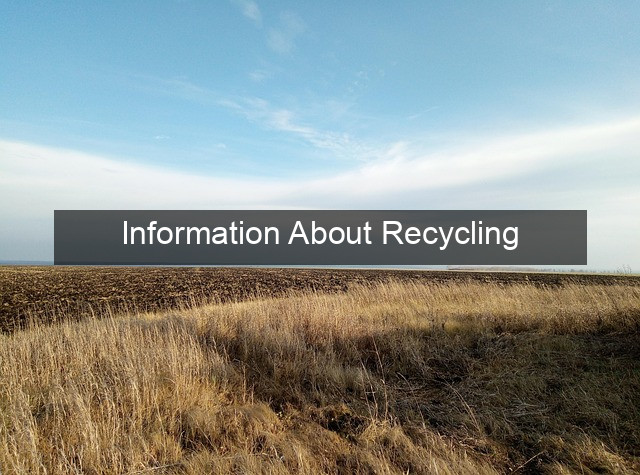Information About Recycling

- Information About Recycling
- The Comprehensive Guide to Recycling: Your Role in a Sustainable Future
- Understanding the Recycling Process
- Collection and Sorting
- Processing and Manufacturing
- The Benefits of Recycling
- Commonly Recycled Materials
- Paper and Cardboard
- Plastics
- Glass and Metal
- Overcoming Recycling Challenges
- Contamination Issues
- Improving Recycling Infrastructure
- The Future of Recycling
- Technological Advancements
- Conclusion
- Frequently Asked Questions (FAQs)

The Comprehensive Guide to Recycling: Your Role in a Sustainable Future
Our planet is facing an unprecedented waste crisis. Mountains of discarded materials clog landfills, pollute our oceans, and contribute to climate change. Recycling offers a powerful solution, transforming waste into valuable resources and mitigating the environmental impact of our consumption. But effective recycling requires more than just tossing items into a bin. It demands understanding the nuances of the process, knowing what can be recycled, and actively participating in creating a circular economy. This comprehensive guide will delve into the intricacies of recycling, empowering you to make informed choices and contribute to a healthier planet.
From the curbside bin to the complex sorting facilities, the journey of recycled materials is a fascinating process. Understanding this journey can motivate us to become more conscientious consumers and diligent recyclers. This guide will equip you with the knowledge and resources to navigate the world of recycling effectively, making a tangible difference in the fight against waste and pollution. Join us as we explore the power of recycling and discover how we can all contribute to a more sustainable future.
Understanding the Recycling Process
Collection and Sorting
The recycling process begins at your curbside or designated collection point. Different municipalities have varying collection methods, so it’s essential to familiarize yourself with your local guidelines. Once collected, materials are transported to sorting facilities, where they are separated based on their composition.
Sophisticated machinery and manual sorting processes work together to separate paper, plastic, glass, and metal. Contamination is a significant challenge in this stage, so proper sorting at the source is crucial. Items that cannot be recycled, like food waste or plastic bags, can disrupt the entire process.
Ensuring your recyclables are clean and free from contaminants significantly improves the efficiency of the sorting process. Rinsing containers and removing food residue can prevent contamination and increase the value of recycled materials.
Processing and Manufacturing
After sorting, the separated materials are processed into reusable forms. Paper is pulped and reformed into new paper products. Plastic is melted and molded into pellets, ready to be manufactured into new plastic items.
Glass is crushed and melted to create new glass containers, and metals are shredded and melted down for reuse in various industries. This transformation of waste into valuable resources is at the heart of the circular economy.
The processing stage often involves multiple steps to ensure the quality and purity of the recycled materials. These processes are constantly evolving, driven by technological advancements and the demand for higher-quality recycled products.
The Benefits of Recycling
Recycling offers a multitude of benefits, both environmental and economic. By diverting waste from landfills, we conserve valuable natural resources and reduce greenhouse gas emissions.
Recycling also creates jobs and stimulates economic growth. Furthermore, it reduces our reliance on virgin materials, which often require energy-intensive extraction and processing methods.
The benefits of recycling extend beyond the immediate environmental and economic impacts. It fosters a sense of community responsibility and promotes a more sustainable lifestyle.
Commonly Recycled Materials
Paper and Cardboard
Most types of paper and cardboard are recyclable, including newspapers, magazines, cardboard boxes, and paperboard packaging. However, certain types of paper, like waxed paper or paper contaminated with food, may not be accepted.
Ensure that paper and cardboard are clean and dry before placing them in your recycling bin. Flatten cardboard boxes to save space and improve the efficiency of the collection process.
Recycling paper and cardboard saves trees, reduces energy consumption, and minimizes the amount of waste sent to landfills.
Plastics
Plastic recycling can be complex, as different types of plastic require different processing methods. Look for the resin identification code (RIC) on plastic items to determine their recyclability.
Commonly recycled plastics include PET (polyethylene terephthalate) and HDPE (high-density polyethylene), often found in beverage bottles and milk jugs.
Recycling plastic reduces our reliance on fossil fuels, conserves natural resources, and minimizes plastic pollution in our oceans and landfills.
Glass and Metal
Glass and metal are highly recyclable materials. Glass bottles and jars can be recycled repeatedly without losing quality. Metal cans, including aluminum and steel, are also readily recyclable.
Ensure that glass and metal containers are empty and rinsed before placing them in your recycling bin. Remove any lids or caps, as these may be made of different materials.
Recycling glass and metal saves energy, reduces greenhouse gas emissions, and conserves valuable natural resources.
Overcoming Recycling Challenges
Contamination Issues
Contamination is a major challenge in the recycling process. Food residue, liquids, and non-recyclable items mixed with recyclables can contaminate entire batches, rendering them unusable.
Proper sorting and cleaning of recyclables are essential to minimize contamination. Educating the public about what can and cannot be recycled is crucial to improving recycling rates and reducing contamination.
Investing in advanced sorting technologies and implementing stricter quality control measures can further address contamination issues and improve the efficiency of the recycling process.
Improving Recycling Infrastructure
Investing in modern recycling infrastructure is essential to enhance the efficiency and effectiveness of recycling programs. This includes upgrading sorting facilities, expanding collection programs, and developing new recycling technologies.
Public-private partnerships can play a crucial role in financing and implementing these infrastructure improvements. Collaboration between government agencies, private companies, and community organizations is essential to achieve sustainable recycling solutions.
By investing in robust recycling infrastructure, we can increase recycling rates, reduce waste, and create a more circular economy.
The Future of Recycling
Technological Advancements
Technological advancements are transforming the recycling industry. New sorting technologies, such as artificial intelligence and robotics, are improving the efficiency and accuracy of sorting processes.
Innovative recycling methods, like chemical recycling, are enabling the recycling of previously difficult-to-recycle materials. These advancements are expanding the range of materials that can be recycled and increasing the value of recycled products.
Continued investment in research and development is crucial to drive further innovation and unlock the full potential of recycling.
Conclusion
Recycling is a vital component of a sustainable future. By embracing recycling practices, we can conserve natural resources, reduce pollution, and mitigate the impacts of climate change. Understanding the recycling process, knowing what can be recycled, and actively participating in recycling programs are crucial steps towards a more sustainable lifestyle.
While challenges remain, ongoing advancements in technology and infrastructure are paving the way for a more efficient and effective recycling system. By working together, we can create a circular economy where waste is transformed into valuable resources, ensuring a healthier planet for future generations.
Frequently Asked Questions (FAQs)
What happens to recycled materials? Recycled materials are processed and transformed into new products, reducing the need for virgin materials.
Why is recycling important? Recycling conserves natural resources, reduces pollution, and helps mitigate climate change.
What can I recycle? Common recyclables include paper, plastic, glass, and metal. Check with your local recycling program for specific guidelines.
How can I improve my recycling habits? Rinse containers, remove food residue, and ensure that recyclables are clean and dry before placing them in your recycling bin.
| Material | Recycling Process |
|---|---|
| Paper | Pulped and reformed into new paper products |
| Plastic | Melted and molded into pellets for reuse |
| Glass | Crushed and melted to create new glass containers |
- Reduce
- Reuse
- Recycle




